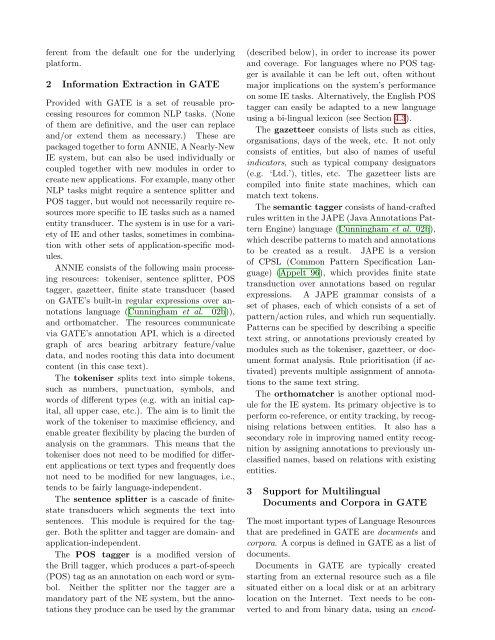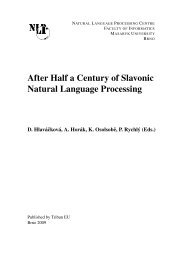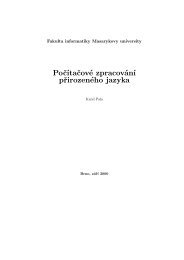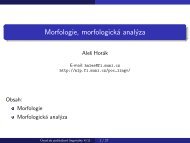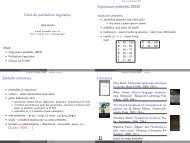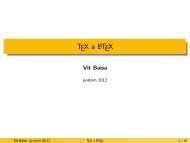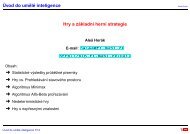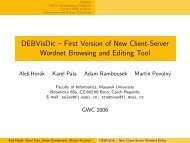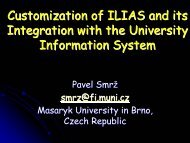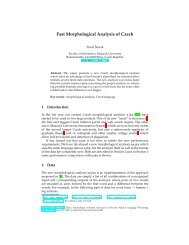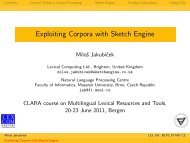GATE: A Unicode-based Infrastructure for Multilingual Information ...
GATE: A Unicode-based Infrastructure for Multilingual Information ...
GATE: A Unicode-based Infrastructure for Multilingual Information ...
Create successful ePaper yourself
Turn your PDF publications into a flip-book with our unique Google optimized e-Paper software.
ferent from the default one <strong>for</strong> the underlying<br />
plat<strong>for</strong>m.<br />
2 In<strong>for</strong>mation Extraction in <strong>GATE</strong><br />
Provided with <strong>GATE</strong> is a set of reusable processing<br />
resources <strong>for</strong> common NLP tasks. (None<br />
of them are definitive, and the user can replace<br />
and/or extend them as necessary.) These are<br />
packaged together to <strong>for</strong>m ANNIE, A Nearly-New<br />
IE system, but can also be used individually or<br />
coupled together with new modules in order to<br />
create new applications. For example, many other<br />
NLP tasks might require a sentence splitter and<br />
POS tagger, but would not necessarily require resources<br />
more specific to IE tasks such as a named<br />
entity transducer. The system is in use <strong>for</strong> a variety<br />
of IE and other tasks, sometimes in combination<br />
with other sets of application-specific modules.<br />
ANNIE consists of the following main processing<br />
resources: tokeniser, sentence splitter, POS<br />
tagger, gazetteer, finite state transducer (<strong>based</strong><br />
on <strong>GATE</strong>’s built-in regular expressions over annotations<br />
language (Cunningham et al. 02b)),<br />
and orthomatcher. The resources communicate<br />
via <strong>GATE</strong>’s annotation API, which is a directed<br />
graph of arcs bearing arbitrary feature/value<br />
data, and nodes rooting this data into document<br />
content (in this case text).<br />
The tokeniser splits text into simple tokens,<br />
such as numbers, punctuation, symbols, and<br />
words of different types (e.g. with an initial capital,<br />
all upper case, etc.). The aim is to limit the<br />
work of the tokeniser to maximise efficiency, and<br />
enable greater flexibility by placing the burden of<br />
analysis on the grammars. This means that the<br />
tokeniser does not need to be modified <strong>for</strong> different<br />
applications or text types and frequently does<br />
not need to be modified <strong>for</strong> new languages, i.e.,<br />
tends to be fairly language-independent.<br />
The sentence splitter is a cascade of finitestate<br />
transducers which segments the text into<br />
sentences. This module is required <strong>for</strong> the tagger.<br />
Both the splitter and tagger are domain- and<br />
application-independent.<br />
The POS tagger is a modified version of<br />
the Brill tagger, which produces a part-of-speech<br />
(POS) tag as an annotation on each word or symbol.<br />
Neither the splitter nor the tagger are a<br />
mandatory part of the NE system, but the annotations<br />
they produce can be used by the grammar<br />
(described below), in order to increase its power<br />
and coverage. For languages where no POS tagger<br />
is available it can be left out, often without<br />
major implications on the system’s per<strong>for</strong>mance<br />
on some IE tasks. Alternatively, the English POS<br />
tagger can easily be adapted to a new language<br />
using a bi-lingual lexicon (see Section 4.3).<br />
The gazetteer consists of lists such as cities,<br />
organisations, days of the week, etc. It not only<br />
consists of entities, but also of names of useful<br />
indicators, such as typical company designators<br />
(e.g. ‘Ltd.’), titles, etc. The gazetteer lists are<br />
compiled into finite state machines, which can<br />
match text tokens.<br />
The semantic tagger consists of hand-crafted<br />
rules written in the JAPE (Java Annotations Pattern<br />
Engine) language (Cunningham et al. 02b),<br />
which describe patterns to match and annotations<br />
to be created as a result. JAPE is a version<br />
of CPSL (Common Pattern Specification Language)<br />
(Appelt 96), which provides finite state<br />
transduction over annotations <strong>based</strong> on regular<br />
expressions. A JAPE grammar consists of a<br />
set of phases, each of which consists of a set of<br />
pattern/action rules, and which run sequentially.<br />
Patterns can be specified by describing a specific<br />
text string, or annotations previously created by<br />
modules such as the tokeniser, gazetteer, or document<br />
<strong>for</strong>mat analysis. Rule prioritisation (if activated)<br />
prevents multiple assignment of annotations<br />
to the same text string.<br />
The orthomatcher is another optional module<br />
<strong>for</strong> the IE system. Its primary objective is to<br />
per<strong>for</strong>m co-reference, or entity tracking, by recognising<br />
relations between entities. It also has a<br />
secondary role in improving named entity recognition<br />
by assigning annotations to previously unclassified<br />
names, <strong>based</strong> on relations with existing<br />
entities.<br />
3 Support <strong>for</strong> <strong>Multilingual</strong><br />
Documents and Corpora in <strong>GATE</strong><br />
The most important types of Language Resources<br />
that are predefined in <strong>GATE</strong> are documents and<br />
corpora. A corpus is defined in <strong>GATE</strong> as a list of<br />
documents.<br />
Documents in <strong>GATE</strong> are typically created<br />
starting from an external resource such as a file<br />
situated either on a local disk or at an arbitrary<br />
location on the Internet. Text needs to be converted<br />
to and from binary data, using an encod-


